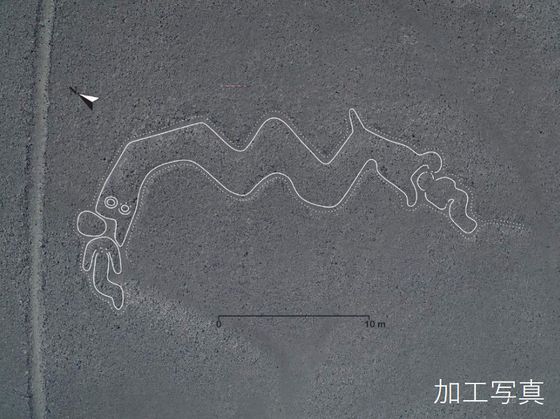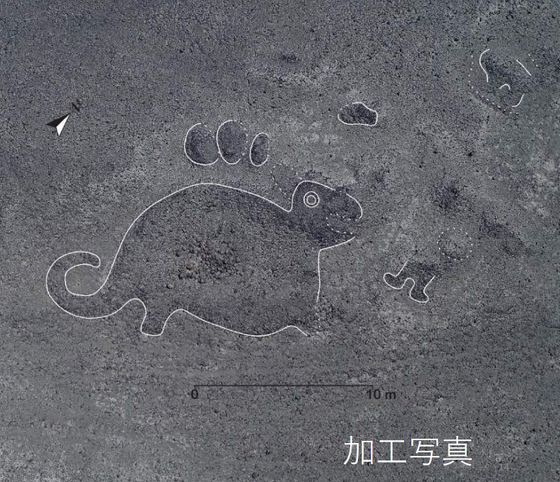IBM's AI succeeded in finding the undiscovered `` Nasca Lines '', the 143 ground lines found are like this

Drawn on the plateau surrounded by the Nazca River and Inhenio river of Peru graphics or pictures '
Discovery of 143 new ground images on the Nazca Plateau and its surroundings -Aiming to grasp the overall image of ground images using IBM's AI (artificial intelligence) technology-
(PDF file) https://www.yamagata-u.ac.jp/jp/files/5115/7380/6345/PRESS_RELEASE_nasca20191115R2.pdf
Archaeologists Seek to Unearth Mysterious Geoglyphs in Peru Using IBM AI and Geospatial Data | IBM Research Blog
https://www.ibm.com/blogs/research/2019/11/nasca-lines-geoglyphs/
Ancient Humanoid-Shaped Nazca Line Discovered in Peruvian Desert | Live Science
https://www.livescience.com/humanoid-nazca-line-discovered.html

There are many Nasca lines that have been investigated since the first half of the 20th century, such as giant

by Wikimedia Commons
At Yamagata University, a research team led by Professor
Meanwhile, Professor Sakai et al. Conducted high-resolution image analysis and field surveys on the entire Nasca Plateau, which was obtained by aerial laser surveys and other means. The research team, which obtained the hypothesis that concrete ground drawings were drawn intensively along multiple paths distributed mainly in the western part of the Nazca Plateau, drew new people and animals as a result of the field survey. It seems that they found 142 ground images.
The following PDF file introduces representative examples of newly discovered ground images.
Representative new ground image
(PDF file) https://www.yamagata-u.ac.jp/jp/files/9315/7380/1009/press2019115_02.pdf
The white line represents a confirmed ground image, and the following ground image is a “killer whale”.

'Human form' and ...

'Two-headed snake and people'

'Human neck'

'fish'

'monkey'

'bird'

'Camelid'

'Human shape and neck'

'Human forms and animals'

The research team reports that 142 ground images such as “Feline” were confirmed between 2016 and 2018. The ground images announced this time were of various sizes, ranging from over 100m to less than 5m. Large ground images are relatively new and were created around 100-300 AD, and small ground images are thought to have been produced between 100 BC and 100 AD.

From 2018 to 2019, the research team also collaborated with IBM Japan to conduct a demonstration experiment using AI to discover new ground images. The research team developed an AI model on the “IBM Watson Machine Learning Community Edition” machine learning platform. The AI model was trained using the existing Nasca ground image data set, and data such as aerial images of Yamagata University were analyzed, and researchers found a ground image candidate that could not be detected so far . As a result of an actual field survey by the research team, a “humanoid” ground image with a total length of approximately 5 meters was confirmed.
The human-type ground image discovered using AI is approximately 4m long and 2m wide. It seems that it is a figure with a stick on its head, and it is speculated that three dots may represent the eyes and nose. In addition, the research team says that this ground picture is distributed near the path, so it may be drawn as a kind of signpost.

Many of the discovered Nazca Lines are not well preserved, and the presence of rivers, irrigation traces, roads, etc. seems to be one of the factors that make it difficult to find them. As demonstrated this time, if you can analyze a large data set using AI, you will be able to discover undiscovered ground images more efficiently.
In the future, Yamagata University's research team will adopt “ PAIRS Geoscope ”, a cloud-based AI analysis technology provided by IBM, and further search for ground images. PAIRS integrates multiple large datasets such as aerial images, satellite images, and geographical survey information and can analyze them at a speed that is impossible for humans. The
Related Posts:








